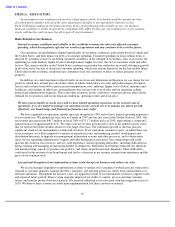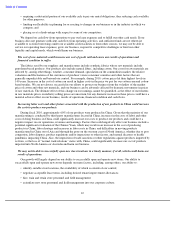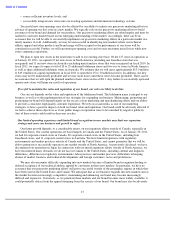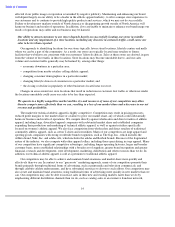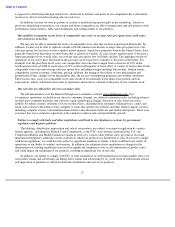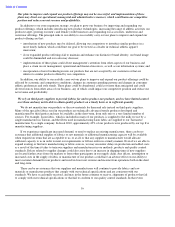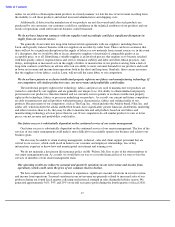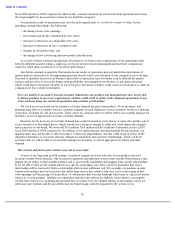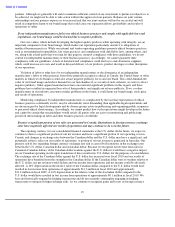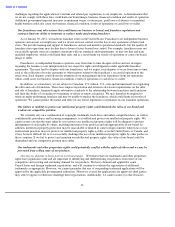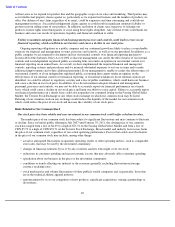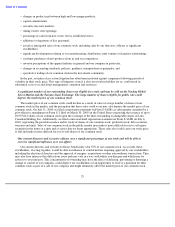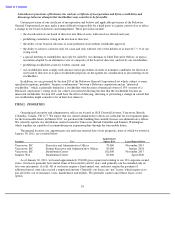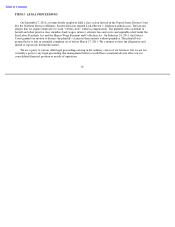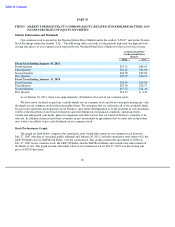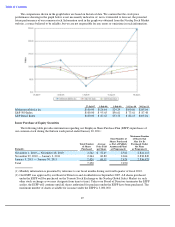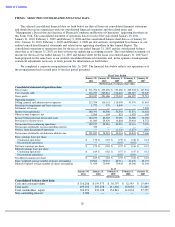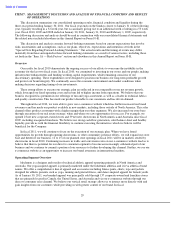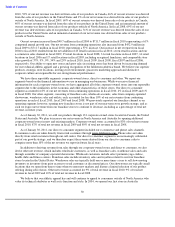Lululemon 2010 Annual Report Download - page 25
Download and view the complete annual report
Please find page 25 of the 2010 Lululemon annual report below. You can navigate through the pages in the report by either clicking on the pages listed below, or by using the keyword search tool below to find specific information within the annual report.
Table of Contents
transactions, depending upon changes in future currency rates, such gains or losses could have a significant, and
potentially adverse, effect on our results of operations.
The operations of many of our suppliers are subject to additional risks that are beyond our control and that
could harm our business, financial condition and results of operations.
Almost all of our suppliers are located outside the United States. During fiscal 2010, approximately 4% of our
products were produced in Canada, approximately 60% in China, approximately 26% in South and South East Asia
and the remainder in the United States, Israel, Peru and Taiwan. As a result of our international suppliers, we are
subject to risks associated with doing business abroad, including:
These and other factors beyond our control could interrupt our suppliers’ production in offshore facilities,
influence the ability of our suppliers to export our products cost-effectively or at all and inhibit our suppliers’ ability
to procure certain materials, any of which could harm our business, financial condition and results of operations.
Our ability to source our merchandise profitably or at all could be hurt if new trade restrictions are imposed or
existing trade restrictions become more burdensome.
The United States and the countries in which our products are produced or sold internationally have imposed
and may impose additional quotas, duties, tariffs, or other restrictions or regulations, or may adversely adjust
prevailing quota, duty or tariff levels. For example, under the provisions of the World Trade Organization, or the
WTO, Agreement on Textiles and Clothing, effective as of January 1, 2005, the United States and other WTO
member countries eliminated quotas on textiles and apparel-related products from WTO member countries. In 2005,
China’s exports into the United States surged as a result of the eliminated quotas. In response to the perceived
disruption of the market, the United States imposed new quotas, which remained in place through the end of 2008, on
certain categories of natural-fiber products that we import from China. These quotas were lifted on January 1, 2009,
but we have expanded our relationships with suppliers outside of China, which among other things has resulted in
increased costs and shipping times for some products. Countries impose, modify and remove tariffs and other trade
restrictions in response to a diverse array of factors, including global and national economic and political conditions,
which make it impossible for us to predict future developments regarding tariffs and other trade restrictions. Trade
restrictions, including tariffs, quotas, embargoes, safeguards and customs restrictions, could increase the cost or
reduce the supply of products available to us or may require us to modify our supply chain organization or other
current business practices, any of which could harm our business, financial condition and results of operations.
We may be subject to potential challenges relating to overtime pay and other regulations that impact our
employees, which could cause our business, financial condition, results of operations or cash flows to suffer.
Various labor laws, including U.S. federal, U.S. state and Canadian provincial laws, among others, govern our
relationship with our employees and affect our operating costs. These laws include minimum wage requirements,
overtime pay, unemployment tax rates, workers’ compensation rates and citizenship requirements. These laws
change frequently and may be difficult to interpret and apply. In particular, as a retailer, we may be subject to
20
• political unrest, terrorism, labor disputes and economic instability resulting in the disruption of trade from
foreign countries in which our products are manufactured;
• the imposition of new laws and regulations, including those relating to labor conditions, quality and safety
standards, imports, duties, taxes and other charges on imports, as well as trade restrictions and restrictions on
currency exchange or the transfer of funds;
• reduced protection for intellectual property rights, including trademark protection, in some countries,
particularly China;
•
disruptions or delays in shipments; and
• changes in local economic conditions in countries where our manufacturers, suppliers or customers are
located.


